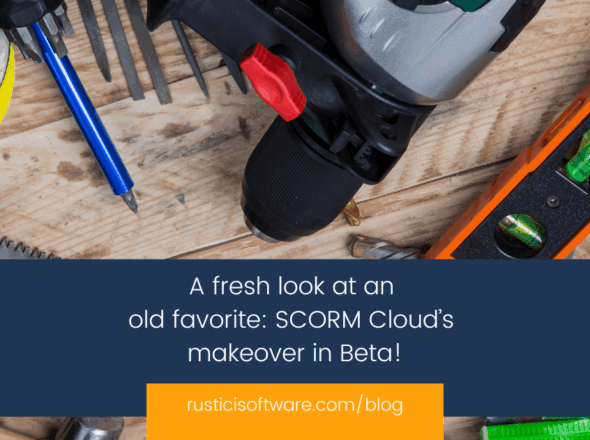2020 forced us all to rethink how we approach work and life in general. Moving to a remote office set up overnight meant carving out space in our homes to work, teach, parent and live. It wasn’t pretty at times and certainly not what we had envisioned, but we adapted and did it quickly. The abrupt shift brought eLearning to the forefront, and we immediately felt the relevance of how our software fits into the bigger picture.
Here at Rustici, we see a bit of everything in the world of eLearning. People come to us with questions that range from “what is SCORM” (or more often, “what is SCROM”) to how to measure the impact of training in their organization. In 2020, the questions came fast and furiously with the increased dependency on eLearning. Fortunately our 2020 product roadmaps we had planned stayed on track, and the questions people asked help us see where the eLearning industry is heading and to inspire what we do next. So we wanted to share our recap of 2020 and what you might expect in 2021.
Looking back
Interest in learning standards, both old and new, are on the rise
For many organizations and subject matter experts, pivoting to eLearning meant an introduction to SCORM and the complexities of getting content and applications to play well together. I don’t think anyone would have predicted that SCORM.com would see a 62% increase in site traffic in 2020. But if we learned anything in the past year, it was to expect the unexpected.
While interest in SCORM skyrocketed, the appetite for more modern standards like cmi5 and xAPI continues to grow, particularly within the Department of Defense. Our award to develop and deliver a cmi5 conformance test suite and open source player are a testament to this commitment. And for those of you who are just getting started with SCORM, know that cmi5 is a great bridge when you want to transition to xAPI.
Support for more content types and standards
With all of the chaos of 2020, we managed to add some pretty exciting features to our products. We furthered development with LTI to help our customers reach new audiences and customers. Rustici Engine became a certified LTI Platform and Content Controller secured certifications as an LTI 1.1 and 1.3 Tool. We also added native support for MP4 and PDF files already supported in Rustici Engine to both Content Controller and SCORM Cloud.
Keeping up with demand and staying safe
The rush to move to online training and learning shined a light on the importance of scalable and secure platforms. We saw record utilization of SCORM Cloud for both production delivery and content testing as more companies and schools moved online. We also saw increased interest from our customers to migrate to our hosting services for Engine and Content Controller to offload the work to manage and scale for increased demand. From a security perspective, we successfully completed ISO certification of SCORM Cloud and our managed hosting services to ensure that we continue to offer safe and reliable software.
It’s almost like being there
In 2020, we learned to adapt, be resourceful and make use of the tools (or ingredients) you have on hand. We had to find ways to recreate the magic of in-person interactions. We traded in our ping pong paddles for Slack trivia competitions and found ways to continue to argue about the definition of a sandwich (and now have a lovely archive of that debate).
Connecting with our customers and the industry as a whole without the help of live conferences had us leaning heavily on video conferencing and webinars. In some ways, this was a positive. I ‘met’ many clients for the first time in the past year thanks to Google Hangout and Zoom. Instead of exhibiting or presenting at live conferences to share our standards knowledge with a wider audience, we shifted to webinars. We covered everything from SCORM basics to learning ecosystems and even worked in some Drawful along the way. While we’d much rather talk to you in person, we’ll continue leaning on webinars in the meantime.
Saying goodbye and hello
We had some significant changes to our company aside from just moving to a remote working environment. We bid a bittersweet farewell to TJ as he moved on to work with our sister company, Peoplefluent. We opened our doors to JCA Solutions and are excited to add George and Dottie to our team and expand our eLearning expertise and software capabilities, along with adding a few new developers and marketing folks.
Looking ahead
With virtual training and learning gaining a stronger foothold in our daily lives, it’s exciting to see where things are heading. Most of the trends we’re seeing aren’t new, but the increased interest and demand is what’s most notable.
Putting the puzzle pieces together
We have seen an increase in the demand and need for offering more content types alongside traditional eLearning formats. Whether it’s sourcing content from 3rd-party libraries, adding video based training and other supplementary materials, we’ve gone well past the traditional authoring tool + LMS model. While not a new concept, the complexity of learning ecosystems is growing. Streamlining the administration of various content inputs, systems and data outputs will be critical, and staying ahead of the problem will help reduce headaches in the future.
Bringing corporate training into the classroom
As we look at ways to train the future workforce, expect to see valuable skills based training and certification programs offered by companies to higher education institutions and vocational schools. For us, this means finding ways to help bridge the gaps between the technologies that have historically served corporate training and education in very different ways (think: SCORM for corporate and LTI for education).
Incorporating learning into other business platforms
Demand for digital learning options only continues to grow and making learning accessible within systems where employees spend their day is on the rise. Companies and software vendors alike are integrating training into enterprise applications beyond LMSs. We can expect to see more enterprise software products look for ways to support learning and training natively.
Making working from home work (still)
As we settle into the winter months, we’ve now seen all four seasons from our home offices. The distance between us doesn’t impact the amount of work we can accomplish. It’s finding ways to inject the personal interactions and make Rustici a great place that’s harder. Chance encounters in the hall or pong room aren’t easy to recreate. Spontaneous conversations and meaningful moments now require effort and can often lose their inherent magic. So we will continue to get creative on how to bring people together, even while we’re apart. And if we crack the code on how to do this, we’ll certainly share it!


